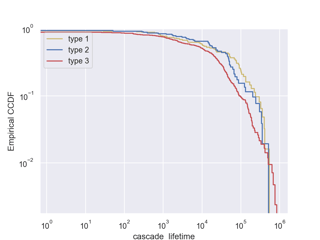I have 3 dataframes with the same structure (each dataframe includes a different type of tweet). Here are the columns of dataframes: id, tweet_time, cascade_lifetime, cascade_size.
I would like to compare the cascade_lifetime and cascade_size of different types of tweets. To do this, I plotted the empirical CCDF of the cascade_size and cascade_lifetime for different types of tweets:
X1 = df_type1 #type1 tweets
X2 = df_type2 #type2 tweets
X3 = df_type3 #type3 tweets
sns.ecdfplot(data = X1, x= 'cascade_lifetime', complementary=True, label = "type 1", color = 'y')
sns.ecdfplot(data = X2, x= 'cascade_lifetime', complementary=True, label = "type 2", color = 'b')
sns.ecdfplot(data = X3, x= 'cascade_lifetime', complementary=True, label = "type 3", color = 'r')
plt.legend()
plt.xscale('log')
plt.yscale('log')
plt.ylabel('Empirical CCDF')
and here are the plots:
My Questions:
Is CCDF the right method to compare data with different sample sizes? my sample sizes are very different, for example, there are 1700 type 2 tweets, and 8600 type 3 tweets, while I only have 100 type 3 tweets. How should I deal with it?
I am not sure how to interpret the plots. Here is my understanding: Most retweet cascades (any type) have lifetime less than ~2.5 hours(1000 s / 3600 = 2.77 h). In general, more number of tweets type 1 (yellow line) have longer lifetime (i.e., lifetime more than a day) compared to other types (100000 s / 3600 = 27.7 h).
Are my interpretations correct? what else we can get from these plots?
NOTES: the distributions of cascade_size and cascade_lifetime in all dataframes are not normal.


